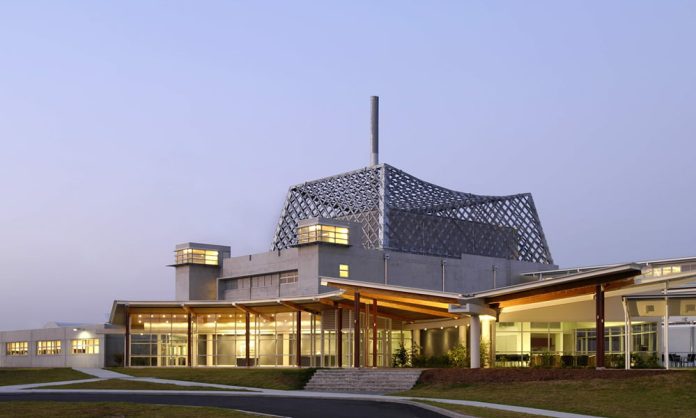ANSTO brings a legacy site, assets worth billions and a complex risk profile together into the sort of challenging, fulfilling electronic security application most security managers can only dream of.
I WAS mighty curious when invited to take a look at the fruits of a recent CCTV and access control upgrade at the Australian Nuclear Science and Technology Organisation (ANSTO) facility at Lucas Heights, in Sydney. As the location of the Open Pool Australian Lightwater (OPAL) nuclear reactor, this is one of the most secure sites in Australia and a dream site for security managers.
My first visit to ANSTO was in the early 1990s when the first Cardax access control solution was installed. Security was simpler then, befitting a much lower risk profile revolving around small groups of demonstrators who sought impactful social commentary rather than serious interference with the facility itself. Back then there was a gatehouse and a fence and some CCTV but it was simple stuff. I drove right in and parked my Pulsar ET Turbo below the now closed HIFAR reactor.
Arriving now is a whole different experience. Security is projected a considerable distance from serious pieces of infrastructure. The educational visitor’s centre is more than half a kilometre down the road. Visitor parking is external to the secure part of the site. No one is driving into this site unauthorised. There are gatehouses and a reception area, with electronic security in layers supporting the site’s physical defences.
Just on four years ago ANSTO restructured its security division bringing in a new team. Part of the restructure saw the general manager security and safeguards role reporting directly to the chief executive officer. This was a key change at a number of levels. For a start, communication from the security team arrives at the CEO fast and undiluted. But underlying this is the fact ANSTO incorporates a management shortcut – you only do this on a site where security is a serious issue.
The restructure provided a rare career opportunity for the new team to conduct a ground-up review of the entire security arrangements at ANSTO without feeling the need to defend the current arrangements. A range of key improvements were identified and provided to the ANSTO executive. The executive team backed up its verbal support on the importance of security by providing more than $A3.5M in capital funding to the deliver on the new security team’s recommendations.
ANSTO is a hard site to encapsulate in your mind and sitting at my desk after the visit I’m not a whole lot closer to comprehending its intrinsic nature. This site is too large in size and complex in nature to tuck up in a single paragraph. There are multiple interest groups exerting profound influences on security protocols.
The temporal layers of infrastructure allow you to pick the earliest buildings as you drive the facility’s gum tree-lined streets. Its age means the site is defined by legacy gear including its hybrid comms infrastructure and this has defined the recent upgrade, which focused on making the system hardware agnostic. In the future the security team can upgrade security devices and network components as required without impacting on operational proficiency.
A key difficulty with this site from a storyteller’s point of view is what the security team is not allowed to say and what I was not allowed to see. For instance, I came away with almost no product shots, and no images of camera views that show the nature of the site’s coverage.
Clearly, the underlying nature of the site mirrors other secure locations in fundamental ways. But it’s a challenge getting a sense of the infrastructure that underlies the sparkling new Geutebruck GSIM VMS, GTECT IVA, and Cardax UltraSec solutions. This challenge is amplified by the size of the facility, which covers 70 hectares, has a 4000m perimeter and includes about 150 buildings.
Looking at the map in the security office, I can see there’s a lot of rugged country surrounding the ANSTO facility. It’s mostly bushland and that means wildlife and an increased risk of bushfire. ANSTO’s 150 buildings all have balanced protection in accordance with the Australian government’s PSPF (Protective Security Policy Framework) for government agencies. The way the PSPF works is that it asks business operators of government agencies to consider their risk matrix – to look at the consequence of an incident and then work out what their site’s risk level is.
Something else that keeps poking its head up during my time at ANSTO is the organisation’s sense of mission in support of community. No matter where our conversation goes the importance of ANSTO’s work for all Australians is just around the corner. Given my own life experience it took about 2 minutes to adopt a position of complete agreement. ANSTO is one of the crown jewels of Australia’s medical system and its loss cannot be countenanced. ANSTO’s management, staff, and security and law enforcement teams are absolutely dedicated to this cause.

Paul Jones, general manager, security and safeguards, ANSTO
According to Paul Jones, general manager security and safeguards, the facility is primarily dedicated to nuclear medicine and cutting edge research.
“One in 2 Australians will receive a nuclear medicine procedure in their lifetime and ANSTO produces 10,000 doses of Molybdenum 99 per week for the domestic and international market,” Jones explains. “Moly 99 as it is known, is used in 80 per cent of all nuclear medicine procedures around the world.
“When our new Moly 99 production facility is built in the next couple of years ANSTO will more than quadruple our production supplying 20-25 per cent of the world’s need for this isotope.” he says. “This and the mind-blowing research being undertaken on the site makes ANSTO a vital part of Australia’s medical and research infrastructure that merits protection.”
ANSTO employs about 1200 staff on the site and on any given day there are around 300-400 contractors working across the facility, making the access control system and administrative procedures vitally important. Facilitated by the security arrangements is visitation by approximately 15,000 students from schools and universities each year who come to the ANSTO Discovery Centre as part of ANSTO’s community engagement.
Something else that’s important at ANSTO is the way staff see the security function. According to Jones, they understand the importance of the site, and this is reflected in their respect for and adherence to security procedures. Members of staff also provide regular security reports on issues that might concern them.
“The culture across ANSTO helps us maintain a secure environment,” Jones explains. “A robust training and awareness program underpins the security culture strategy – there’s a strong security culture embedded in the organisation.”
Something else to note is that ANSTO is only becoming more valuable. The $A600 million OPAL reactor was opened in April 2007 and there is currently another $A240 million worth of capital works taking place. Among these projects is the ANSTO Nuclear Medicine Facility, Australia’s newest and most innovative, which will provide cutting edge medical isotopes to the world. ANSTO is also building a first of a kind nuclear waste facility. The new SYNROC plant will provide a step change in nuclear waste management and prove Australia is at the cutting edge of technological advancements.
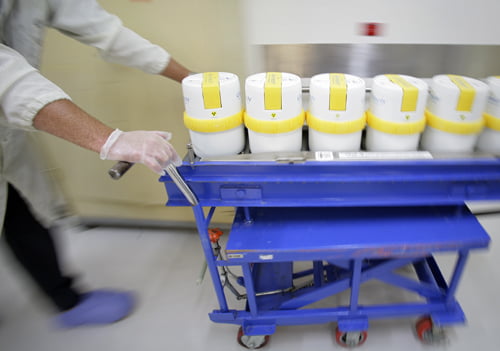
“These new facilities will marry the latest techniques for medical isotope production and waste management with high end technology and be enveloped with high tech security,” Jones says. “It has given our security team the opportunity to be involved in the building design so that security is an integral part of the design rather than an add on.”
Something else for readers to take into account is the necessary external stakeholders whose protocols govern the security function at the site. Because ANSTO operates in the nuclear and radiological space they have to apply not only the PSPF, but have to meet The International Atomic Energy Agency’s (IAEA) recommendations for nuclear and radioactive facilities. These recommendations are managed in Australia by 2 regulators the Australian Safeguards and Non Proliferation Office (ASNO) and the Australian Radiation Protection and Nuclear Safety Agency (ARPANSA).
ANSTO also has a serious onsite law enforcement response capability and the availability of this response interacts with the electronic security systems. The Australian Federal Police are on site 24 x 7 and can be quickly supported by the local and tactical operations capability of the New South Wales Police. ANSTO hosts regular security exercises to ensure coordination of response works seamlessly.
ANSTO’s security operations are intelligence-led and look at the business impact level that a compromise or failure would have. The business impact level determines the security classification levels and from there physical security requirements are designed.
The ANSTO system
System topology is hybrid at the edges but the whole point of this upgrade is bringing everything into an holistic digital architecture as part of a roadmap encompassing the entire security application at ANSTO. It goes without saying that underlying all its security technology is infrastructure – lots and lots of infrastructure.
ANSTO operates a fibre backbone and a separate dedicated LAN for security systems, which is administered by the IT team and has multiple layers of redundancy. A particular security clearance is required to get onto the system and view any part of it.
“Something I am really interested in hearing about is the path the cameras follow from poles in the field to node zero,” I ask. “What is the network topology you are using?”
ANSTO’s physical security advisor Marcus Wiltshire has joined the discussion about the physical security solution. As soon as he opens his mouth you know Wiltshire has the sort of lateral technical mind you only seem to find in security engineers.
“At ANSTO, topology depends on a number of things,” he tells me. “If it’s an old school analogue it comes along coax but with the LAN it depends on distance. You only use fibre if the distances are greater than the 90m threshold – if we have a camera close enough we don’t use fibre. For instance, if you have a server here and a camera on the perimeter at 60m and a network switch here, you can reach that switch with copper Cat-6e – so it’s copper to the nearest switch and then onto the fibre backbone to the server.
“Something we like to implement is that if you are bringing networks into buildings we always use fibre anyway because it does not transmit any electrical surges or currents,” Wiltshire says. “So if you’re going to have a camera over here and a building here, depending on the distance, you’ll have fibre to the pole, a mini-switch at the pole and you will have a normal network switch in the building and you’ll have your fibre backbone back to the central server.
“We are not doing anything other sites may not do, but this is a unique site – it’s very large and it has legacy infrastructure so we need to mix copper and fibre – it works for us.”

ANSTO physical security advisor, Marcus Wiltshire
As being subject to PSPF the ANSTO security team is also subject to the Australian Government’s information security manual. ISM dictates how ANSTO’s networks are configured and in line with ISM, there are a number of data centres across the site and there are redundant recorders spread through these data centres. Image streams go to the data centres for recording and then are available at the monitoring centre. When it comes to the network side, ANSTO has encrypted communication across the site between all devices and the ANSTO Security Operations Centre (ASOC) provides that awareness to the AFP teams.
The nature of the site from an electronic security systems perspective is that it includes a highly secure inner area containing OPAL and other assets, which is defended in depth by an outer perimeter, a sterile zone and an inner perimeter. On this perimeter physical and electronic defence mechanisms protect the site’s integrity and action rapid response.
Within the perimeter all individual buildings are defended and key areas are monitored with CCTV. But the perimeter is the key defensive element of the system. Multiple different technologies monitor the perimeter, which is broken into zones to allow small sections to be deactivated for maintenance while being monitored live by the ASOC.
“ASOC monitors the perimeter using optical cameras, thermal cameras, microphones and other technologies – so there’s a human element, not just an electronic detection capability that’s integrated and multi-layered,” says Wiltshire. “The system is deliberately designed so there is a level of automation as well as manual review by humans to provide that extra layer.”
According to Wiltshire, there are plenty of areas of the site that allow the team to get creative with the functionality of the security technologies being used.
“This system can be used for safety, auditability and security,” he explains. “We find in some areas the safety component will exceed security and in others security is more important and we focus on what is most important for that location.”
What are the new solutions that have been installed at ANSTO that facilitate the digital transition?
“On the access control side we use Gallagher’s Cardax UltraSec solution, which is Type-1 endorsed by the Security Construction and Equipment Committee,” Wiltshire says. “Our CCTV infrastructure and platforms include Geutebruck GeViScope NVRs and Geutebruck’s GSIM VMS and this solution was commissioned in April 2014. It follows a distributed topology supporting 300-400 cameras and there are plans to extend this coverage further.
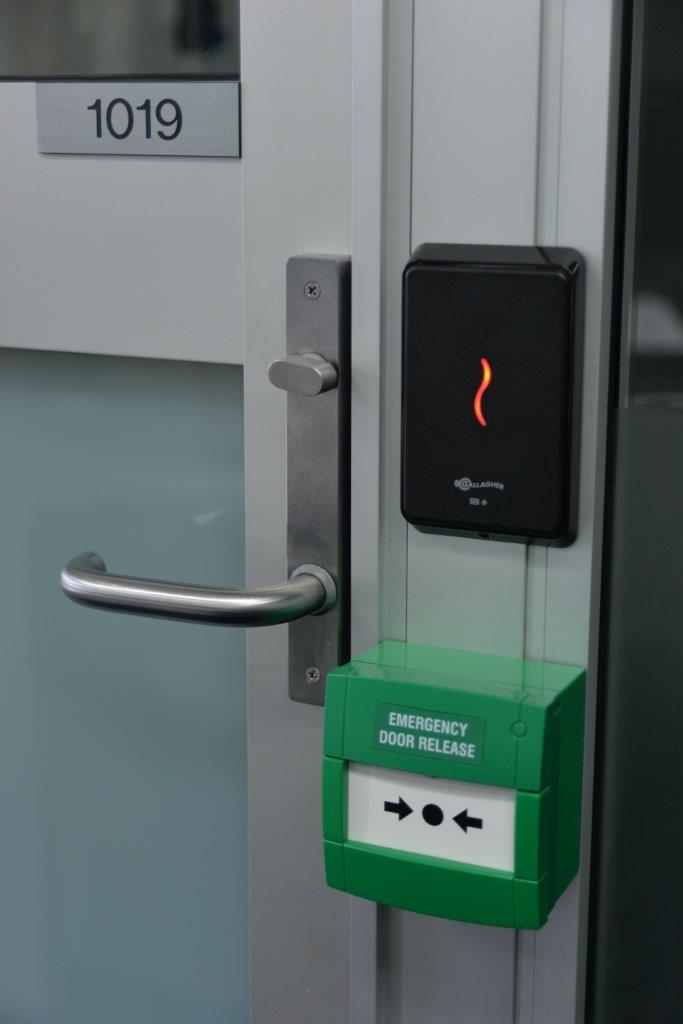
“When it comes to cameras, we use FLIR thermal cameras on the perimeter, Axis optical cameras (Q60E Mark 2 PTZs), which we have found to produce excellent images. We also installed Axis indoor cameras as part of this most recent upgrade.”
As Wiltshire tells it, the nature of GSIM is that it’s essentially a VMS that sits on top of the entire system in its own server.
“GTECT IVA is done at the NVR level and the GSIM sits on top and gives you a polished VMS for alarm event management and viewing of live and recorded image streams,” he says.
Does Cardax integrate with that?
“With Cardax, because it is a Type 1 system you are limited with the amount of integration you can do. We have low level integration. Access control and intrusion detection system is managed separately from the video surveillance system but video footage is recorded with access and alarm events.
“There are also a number of access control points across the site that are more sensitive than others that we keep a close eye on,” says Wiltshire. “In these locations as soon as someone goes to the area it will come up for viewing by operators.
“We can also conduct real time visual authentication of a person before they go into a location – that process is automated – the entire system is automated to the point where we may use the system to authenticate identity or we may use federal police – depending on our security posture at the time – it’s scalable and adaptable.
“Operationally, the way our alarm screen works is that it gives you a recurring snap shot of when an event actually happened, a paused image of event recurred and then a live image and leaves you a free screen to throw a camera in and do whatever playback you want.”
“What about intrusion alarms – does the site use these or are the sensors all internal?” I ask.
Here the team is a little more cautious explaining “We can’t give you specifics but we do have use external sensors and we monitor walls, ceilings, doors, rooftops – a combination – PIRs, seismic, PE and others.”
When it comes to security technology, ANSTO’s thermal perimeter is a key aspect of the site’s security solution and it incorporates a virtual thermal fence through integration with Geutebruck GSIM and GTECT IVA so as to maintain a single recording platform site-wide.
Importantly, too, GTECT is applied across the board to optics and thermal. Bear in mind here that analytics is done at the recorder level – there’s not a dedicated analytics server – the Geutebruck GeViScope has the smarts to handle IVA using an application of GTECT software. According to Wiltshire, using FLIR cameras gives the team an ONVIF-compliant IP stream that can be analysed using the GSIM platform to activate alarm events at ASOC generating assessment and rapid response.
“Dual sensor analytics at the recorder allow us to intelligently analyse our images in a number of environments regardless of variables like camera pole movement and yet we still get reliable intrusion detection on a day with 70kmph winds,” explains Wiltshire.
“Detection and identification is what we focus on. When an alarm is generated and a number of events happen, PTZ cameras will turn to the area, there are zones and all are individually armed. This allows us to turn off part of our perimeter during the day if we have maintenance going on while still having a number of other layers active.”
When it comes to Geutebruck, did you need to do some customisation to get the system to work in the way you wanted it to work?
“Because Geutebruck’s GTECT is such an intelligent analytic, there’s lots of design work required to ensure we get the best out of it – it’s not just a standard old school IVA that looks at differences in pixels,” Wiltshire explains. “It has the smarts to be able to work out depth of field – you set a metre distance in your image from one point to another so the system knows that it looks for a person at 100m with less pixels that it looks for at 10 metres.”
According to Wiltshire, it’s detection within detection.
“This is due to the fact you’ve got this intelligent system which allows you to define detection zones and set a particular depth of field using different parameters for a particular zone,” he explains. “This means you’ll have 30 different detection zones in one image all running at the same time.
“It’s robust and flexible. If your building is blocking half the image and the roof needs to be detected at a different rate to someone approaching the fence then you can set individual levels of sensitivity for detection zones (boxes) within the image.
“When you’ve got your field of view, you tell GTECT that at this point in the image a target will be this high and at this point it will be this high, but at that height the target is at that depth of field – the system then works out exactly what it’s looking for,” Wiltshire explains. “It’s fantastic.”
“Is there anything that challenges the thermal fence or does this clever IVA handle everything that’s thrown at it?” I ask. “You would have lots of wildlife here, which would make that depth of field perspective very important.”

Pole-mounted FLIR thermal cameras.
“With any high end system there is always a teething/settling in period and at first you have to work out your sensitivity levels so you are not getting wildlife setting it off, only people,” says Wiltshire. “Over the period of commissioning we were able to get the system as we wanted it. You set the sensitivity threshold so you are only detecting intruders of a certain size.
“The beauty of IVA on the service side is that it doesn’t discriminate whether it’s seeing a black and white thermal image or a full colour HD video image – it’s just analysing pixels but with a lot of smarts on top of it. The engine is so advanced and so powerful.”
One thing that comes through loud and clear – the security team appreciates the efficiency, the simplicity and functional power of thermal cameras in this sort of application. With optical CCTV, there’s the cost of installing the lighting, the day/night camera, the teams says. Then you struggle with the quality of the image through a 24-hour cycle.
“What we love about thermal is that you just install the camera and you know what you will get day and night. There are no additional considerations and that makes the technology very appealing.”
The upgrade process
The upgrade to Cardax UltraSec and Geutebruck took just over a year. That upgrade plan started off with some intense reprogramming of existing systems, some conducted by Secom Technical Services, that includes databases, schematics, ASBILTs, – much of that process was handled by Wiltshire who cut his teeth in electronic security integration at Secom STS.
“Once we had got that as we wanted it we moved on to design and then to the installation of the cameras and NVRs by integrator ECS,” Jones explains. The access control side was handled by Wormald Security, which also took care of some of the high security applications across the site.
On the surveillance side, Geutebruck Australia and engineers from Germany have been heavily involved. ANSTO accepted a beta GSIM so partnered with Geutebruck to assist them with development of that solution. It was a strategic partnership and ANSTO worked with them to make the system fit for purpose, as well as being fit for other users. Teaming up with Geutebruck as a beta site was a real win, according to Wiltshire.
“This arrangement gave us the advantage of having site specific customisation as we fed information back to Geutebruck about what we needed from the system,” he says. “That’s an ongoing relationship, too. The hard programmers have attended and we’ve been able to chew their ears off, we’ve had round tables, it’s been fun and valuable from our perspective. They have been very accommodating.”
According to the security team, Gallagher has also been fantastic.
“We talk with them at the highest level,” Wiltshire says. “The team has a relationship with Sir William Gallagher and he’s been a wealth of knowledge.”
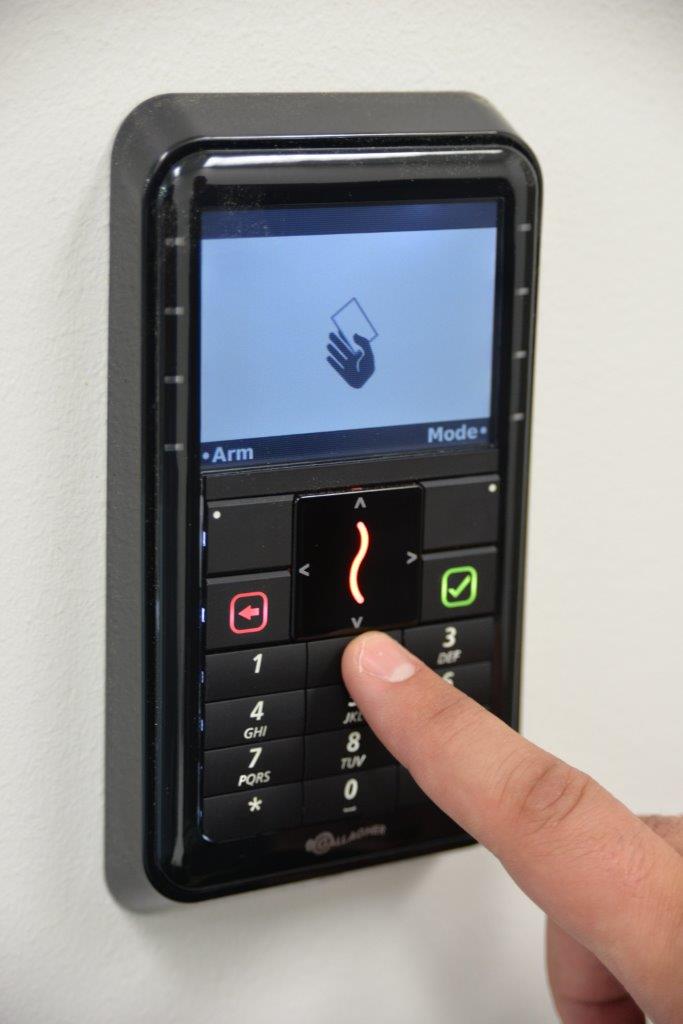
But while ANSTO has worked with Gallagher very closely, the team has not done a lot of development with them. Cardax UltraSec is a Type 1 SCEC-endorsed product as delivered and that limits what can be done with it while remaining compliant.
“When it comes to access control, is all the old RS-485 still in place in some locations?” I ask.
“Yes, in some areas you have a controller connected to LAN cable and from there you have expanders,” Wiltshire explains. “But the readers from the new Gallagher system use an H-bus – the T-11s and T20s. They are very clever. You can push firmware upgrades out to the reader and there are other smart things that can happen including pushing information to readers to tell cardholders their badge is going to expire in 2 months.
“The idea at ANSTO is to build a system so that wherever there is a LAN cable anywhere on the site a reader can be installed at either end and you can upgrade firmware whenever you need to.”
This standardisation of underlying infrastructure is what the upgrade is all about and it applies to CCTV and access control systems. Once the network is in place future devices can be run into it wherever they are needed. This mitigates the cost of labour in the future as the system evolves.
Visting the OPAL reactor
Visiting the $A600 million OPAL reactor, a project that commenced in 2006 and was opened in 2007, is impressive. It’s an understated facility, the steel screen designed to protect the reactor core from aeroplane attacks is the key visual feature.
Security is ramped up considerably when you visit the OPAL. I change my visitor pass for an OPAL pass and sign in a second time with my escort, Wiltshire. We go past the manned checkpoint and through the access controlled turnstile, then through a geigercounter scanner and onwards to the viewing room.
Being in the presence of a nuclear reactor is a definite thrill. It is, as the name suggests, an open pool reactor where you can look through the water (which acts as great shielding from the radiation) down to the core of the reactor.
Underneath the dark surface of the reactor pool are the fuel cells and spent fuel as well as the pods for installing medical treatments and silicon slabs, which are irradiated to make them more conductive for applications like high speed rail. This is really the rubber-road contact point at ANSTO.
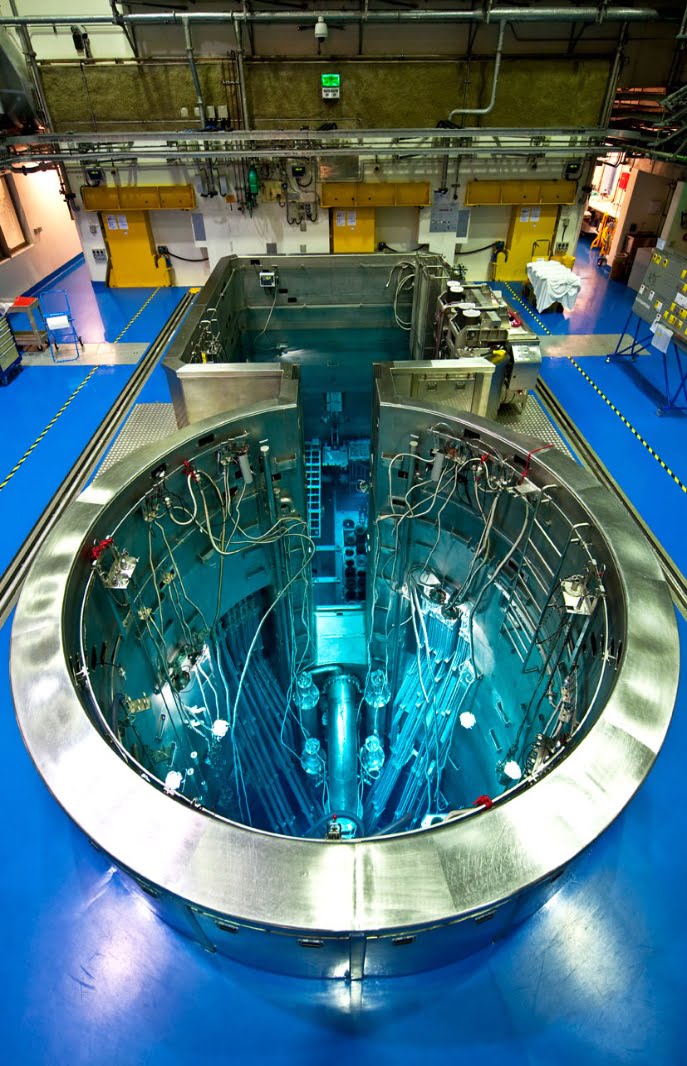
Inside the OPAL reactor.
A big PTZ is steered around to point out the features of the reactor. This is a Pelco Spectra – an analogue PTZ – running through a Pelco keyboard. It’s ideal for this environment. You can still tell the Spectra was a great PTZ in its day. We aren’t seeing HD quality images but there’s good contrast, colour rendition and sensitivity to variable lighting across the complicated scene. The Spectra’s enormous zoom comes into its own here, too. Instead of zooming across carparks and stadiums as it was designed to do, the Spectra is allowing us to zoom right in on small components at the heart of the reactor from a distance of about 10-12 metres.
But what this Pelco Spectra represents most clearly is nature of the site’s hardware. There’s still plenty of high quality legacy equipment being used at ANSTO and the recent upgrade has been all about opening up infrastructure and management systems to meet the future. With these key changes now made, the site can move in any direction it needs to go, as well as retain quality devices that remain eminently fit for purpose.
ASOC security operations centre
The ANSTO security operations centre is accessed through a plain door in the wall of a non-descript building. Only when you find yourself in a mantrap being stared at by a recent-model Sony camera do you realise ASOC meets and exceeds ASIAL’s Grade One control room standard. This security operations centre is clearly new.
It’s a good size and there’s none of the chaotic horror of network racks you often see sharing space in security control rooms. The plan is open with a number of workstations arrayed in front of a very large video wall. On the workstation benches are screens that show the event log of the access control system, including intrusion events.
Not surprisingly, there are a lot of cameras being displayed on the wall at ANSTO, covering road approaches, key entrance points and areas around the facility that need special attention. I have fantasies of getting lovely photos of the operations centre showing myriad camera views but it’s not to be.
According to Wiltshire, the perimeter is recorded at 12.5 frames per second so as to give 30-day storage and the idea is that the constant 12.5 frame rate saves having to mess around setting up recording ramp ups during alarm events. Looking at the screens it seems to me this frame rate is ideal for an application like this one.
ASOC’s cameras are working to give situational awareness in real time and operators are backed up by an AFP response. Furthermore, wider angle lenses with enormous depths of field on large sites don’t give exceedingly fine details, instead they offer useable detail throughout an image. Supporting the primary recorders, all incidents and events are stored on a separate 20TB server in another secure location.
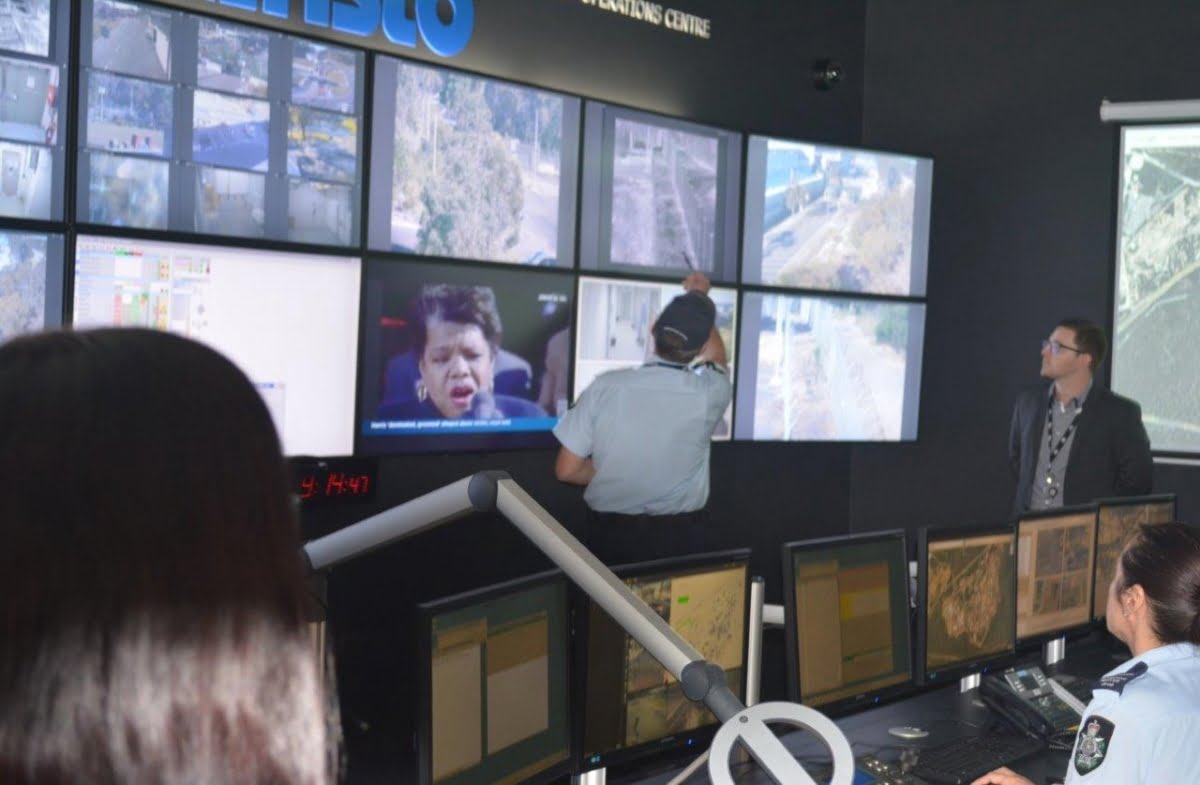
ASOC control room
The control room proper is divided by a glass wall from an equally large space containing a large table, which in the event of an incident will become the security command centre where the ANSTO team, police commanders and other security agencies would drive the system. Around the walls are digital projectors allowing key video feeds to be displayed in wall sizes to assist decision makers when the security command centre is activated. It also allows GPS monitored delivery vehicles to be displayed.
“ASOC has been designed to meet the requirements of the IAEA for what they call an alarm station and what we would call a monitoring centre,” says Wiltshire. “All the site’s security operations are operated and monitored from this location. We have divided the site and the systems supporting it into 3 different security levels based on criticality and that’s how the system has been configured as well.”
According to ANSTO, their ASOC has no computers in it, instead being fed through a server, and it’s completely disconnected from the Internet. It’s got full redundancy, load sharing, there’s a mirror of this facility on site.
“The video wall is managed by Geutebruck GSIM and allows the operators to view live image streams, view events in secure areas, undertake playback recordings, to do any investigation required to give the security team the information they need,” Wiltshire explains. “For instance, you can see the monitor on the workstation there showing the events coming in from the Cardax system and associated with these events are images.”
I look at the monitor – and events are streaming onto it in a constant flow. Given the modest number of staff on the site what this highlights is the large number of access controlled doors with 2-way authentication, as well as the site’s rigorously followed access control procedures.
According to ANSTO, the control room is run by at least 2 operators around the clock, monitoring not just security but safety systems – ventilation and contamination. ASOC was purpose-built from an old, dingy and barely usable space into a very functional and flexible operations centre. It’s hardened it to the point the team has absolute certainty that if there was an incident of any kind, ASOC could continue to operate.
“ASOC is designed with operators in mind, it’s totally ergonomic,” Jones explains. “We partnered with Thinking Space to create the workstations, ergonomic chairs, the desk height is fully adjustable so operators can sit or stand.”
“Is there an external monitoring capability in the event of an incident?” I ask.
“ANSTO has a number of business continuity arrangements in place,” Jones says.
Now we’ve got a sense of the control room, we take a look at the thermal cameras guarding the perimeter of the site. They are classic FLIR. The range is good, contrast is nice, even on a relatively warm and muggy summer day in Sydney. Range is typical thermal, it’s simply enormous. The situational depth of field looks to be hundreds of metres on some thermal camera views, though the programmed zones are probably much less.
Looking at the sterile zone you can see the pileup of broken branches and leaves from a recent wind storm and I get a sense of the challenges of keeping a 4km perimeter surrounded by virgin bush free of debris. There’s vegetation management at ANSTO but it really must be an ongoing battle. Wiltshire pulls up another camera to show a typical cross section of the perimeter – the fence, the razor wire, the gravel in the sterile zone, which supports FLIRs thermal cameras by enhancing contrast. I can see a clear delineation between the secure side, the sterile zone and the unsecured side.
“What operators like about thermal is that it doesn’t discriminate based on time of day – it just gives you the image,” Wiltshire says. “We had our teething problems in the beginning – we were detecting snakes, rats, lizards, we were getting everything, so it was about finding the right balance. But for an application like this, a 24-hour site, thermal is unbeatable.”
According to Wiltshire, ASOC is the core manifestation of the infrastructure investment at ANSTO. It allows the entire system in the field to be turned upside down while the system interfaces in the control room remain utterly composed.
“There are no computers here to upgrade, there’s nothing to restrict you,” Wiltshire explains. “We now have the infrastructure to change whatever we need to change in the engine room – the server room – with no impact on the operators. That was exactly what we were looking for with this upgrade.”
When we finish our tour, it’s pointed out that ANSTO was recently rated 1 in the world for nuclear security. This is put down to the modest nature of Australia’s nuclear capacity but there’s more to it than that, in my opinion. ANSTO’s vital work in saving human life, locally and globally, make it a unique site and the entire operation vibrates with this sense of purpose.
Conclusion
ANSTO is a fascinating site. It’s massive, with external carparks, a remote visitor’s centre and adjacent facilities. Distances are enormous. It’s located in Australia’s largest city. There’s tree cover, multiple buildings and structures, road infrastructure, an internal fenced perimeter, new buildings, a buffer zone into bushland and an AFP response team. Any one of these things would be challenge enough and yet there’s still more to the story.
This is a highly secure site, it has inherent vulnerabilities and risks and its primary purpose is assisting the medical profession treating and diagnosing serious illness. You wouldn’t necessarily expect a facility’s entire culture to be imbued with a sense of high community purpose all the way through to the security function but that’s definitely the case at ANSTO.
The whole security team displays a rare passion for the facility. I’ve seen this level of intensity approached in one or 2 cultural sites in the past but even applications that highly value security, such as universities, don’t reflect the transcendent sense of mission I feel at ANSTO.

ANSTO also has an internal culture in which security seems integral to the principles of the organisation. It’s a passion that’s reflected in the nature of the electronic security upgrade. It’s not just the level of security and flexibility offered by the Gallagher and Geutebruck systems, it’s also the way these organisations have worked together in an alliance with ANSTO, not only to secure a vital facility but to improve their mutual solutions.
According to the security team they also get excellent support from management. One of ANSTO’s mottos is ‘Safe, Secure and Sustainable’ and the importance of security to this site is reflected in the way the security function is respected from the CEO down.
“ANSTO is an amazing organisation and has a bright future,” Jones says. “It continues to deliver for all Australians and it’s a wonderful place to work.” ♦
By John Adams




